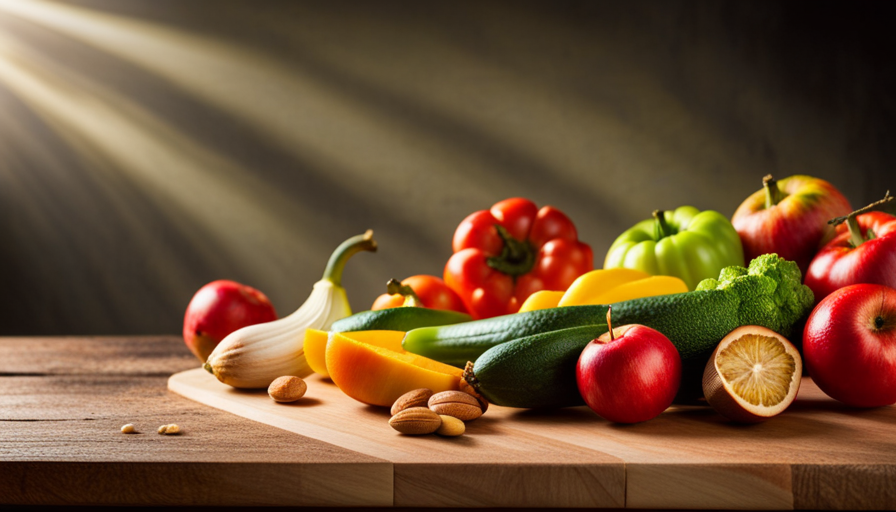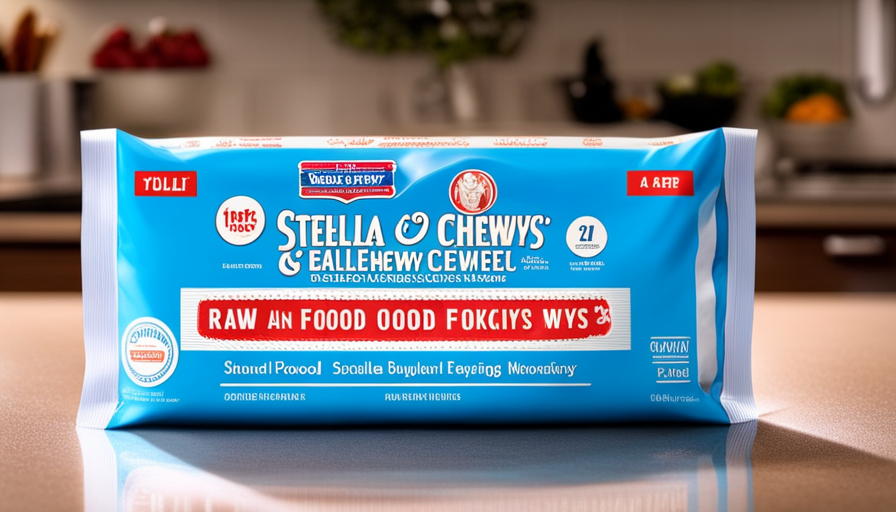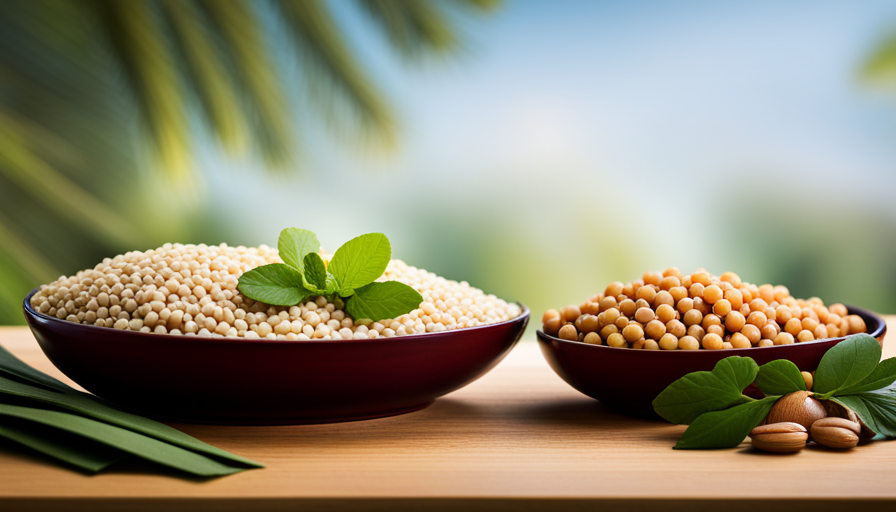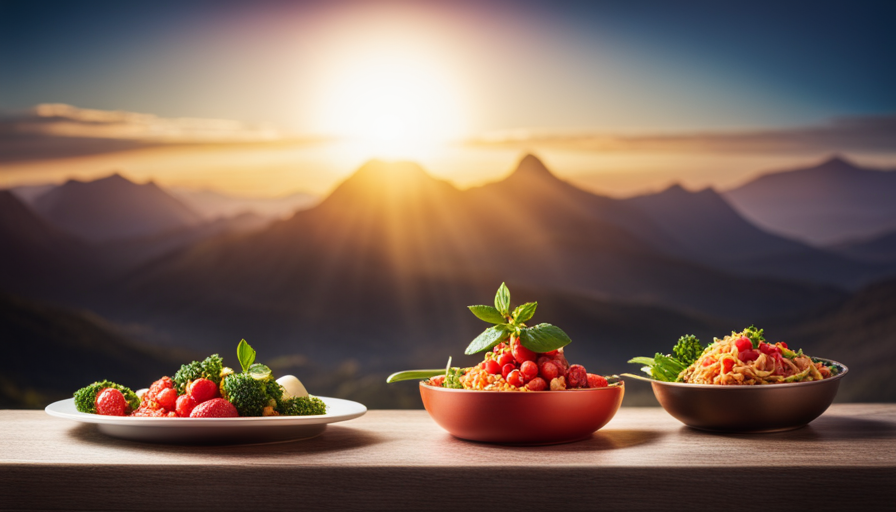Have you ever pondered the secret nutritional gems hiding within raw food?
It’s like peering into a treasure chest, discovering the vibrant colors and flavors that Mother Nature has to offer.
But what about the calorie content of raw food? Are these natural wonders calorie bombs waiting to explode on our waistlines? Fear not, for I am here to shed light on this topic.
In this article, we will delve into the calorie content of various raw food groups, including fruits, vegetables, nuts and seeds, and whole grains.
We’ll explore how to incorporate these nutrient-dense foods into a balanced diet and manage our calorie intake effectively.
So, join me on this enlightening journey as we debunk common myths and embrace the nutritional benefits of raw food.
Get ready to unlock the true power of raw food and nourish your body from the inside out.
Key Takeaways
- Raw food, such as fruits, vegetables, and mushrooms, are generally low in calories and high in nutrients.
- Drying fruits can increase their calorie concentration due to the removal of water content.
- Nuts and seeds are high in calories due to their fat content, but mostly contain healthy fats.
- Whole grains are an excellent source of fiber, vitamins, and minerals, but portion sizes should be considered for effective calorie management.
Understanding the Basics of Raw Food
When it comes to raw food, it’s important to understand the basics and know how many calories are in it. Understanding the health benefits of raw food is essential for incorporating it into our daily meals.
Raw food is rich in vitamins, minerals, and enzymes that are often destroyed during cooking. These nutrients play a crucial role in maintaining our overall health and well-being.
Incorporating raw food into our daily meals can help boost our immune system, improve digestion, and increase energy levels. Raw fruits and vegetables are particularly beneficial as they’re low in calories and high in fiber, making them great for weight management. They’re also packed with antioxidants, which can help reduce the risk of chronic diseases.
Now, let’s explore the calorie content of fruits. Fruits are a popular choice when it comes to raw food, and they offer a wide variety of flavors and textures. From sweet and juicy oranges to tart and refreshing apples, fruits can be enjoyed on their own or incorporated into delicious recipes. Understanding the calorie content of different fruits can help us make informed choices and create balanced meals that meet our nutritional needs.
Exploring the Calorie Content of Fruits
The calorie content of fruits can vary, but it’s worth noting that they’re a nutritious choice for those looking to maintain a balanced diet. When exploring the impact of fruit ripeness on calorie content, it’s important to consider that as fruits ripen, their sugar content increases, which can also lead to a higher calorie count. For example, a ripe banana may have more calories than an unripe one.
Another factor to consider is the difference in calorie content between dried and fresh fruits. Drying fruits removes most of their water content, resulting in a higher concentration of calories. So, while a cup of fresh grapes may have around 60 calories, a cup of raisins can have up to 460 calories due to the removal of water.
These variations in calorie content emphasize the importance of considering the ripeness and preparation method of fruits when tracking calorie intake.
Moving forward, let’s delve into discovering the calorie count of vegetables.
Discovering the Calorie Count of Vegetables
Vegetables offer a rainbow of flavors and textures that can satisfy any palate. Not only are they delicious, but they also provide a plethora of health benefits. When it comes to calorie count, vegetables are generally low in calories, making them a great choice for those watching their weight or trying to maintain a healthy lifestyle.
One vegetable that stands out in terms of its calorie count is mushrooms. These fungi are not only low in calories, but they also offer a wide range of nutrients. For example, a cup of raw mushrooms contains only about 15 calories, making them a great choice for adding volume and texture to meals without adding excessive calories.
In addition to mushrooms, many other raw vegetables are low in calories and high in nutritional value. Leafy greens like spinach and kale are packed with vitamins, minerals, and fiber, while cruciferous vegetables like broccoli and cauliflower provide a good dose of antioxidants. Other vegetables like bell peppers, cucumbers, and tomatoes are also low in calories and rich in nutrients.
As we move forward in exploring the calorie content of different foods, we will now uncover the calorie content of nuts and seeds.
Uncovering the Calorie Content of Nuts and Seeds
Get ready to discover the calorie content of nuts and seeds, because they’re packed with nutrients and make a delicious and satisfying snack option for you! When it comes to uncovering the calorie content of nuts and seeds, it’s important to note that they’re generally high in calories due to their fat content. However, these fats are mostly healthy fats that are beneficial for our bodies.
For example, almonds have around 160 calories per ounce, while walnuts have approximately 190 calories per ounce.
It’s worth mentioning that the calorie content can vary depending on whether the nuts and seeds are raw or cooked. Roasting nuts and seeds can slightly increase their calorie count due to the loss of water content during the cooking process. However, the difference is usually minimal and doesn’t significantly impact the overall calorie content.
Understanding the calorie count of whole grains is the next step in our journey towards discovering the calorie content of raw foods.
Understanding the Calorie Count of Whole Grains
Delve into the delectable domain of whole grains to discover their divine and diverse calorie content as you journey towards a healthier you. Understanding the calorie count of legumes and exploring the calorie content of raw dairy products are essential for making informed choices about your diet. To help you navigate through the calorie content of whole grains, here is a comprehensive table showcasing the calorie count of some common varieties:
| Whole Grain | Calories per 100g |
|---|---|
| Brown Rice | 111 |
| Quinoa | 120 |
| Oats | 389 |
| Barley | 354 |
Whole grains are a fantastic source of fiber, vitamins, and minerals. However, it’s important to keep in mind that portion sizes can greatly impact the overall calorie intake. By incorporating whole grains into your diet, you can enjoy their nutritional benefits while managing your calorie consumption.
As we continue our exploration of calorie content, the subsequent section will delve into the fascinating world of exploring the calorie content of raw animal products. Without further ado, let’s uncover the calorie content of these protein-rich foods.
Exploring the Calorie Content of Raw Animal Products
Now that we have a good understanding of the calorie count of whole grains, let’s explore the calorie content of raw animal products.
As someone who follows a balanced diet, I find it important to consider all aspects of my food choices, including the nutrients and calories they provide.
Raw animal products, such as raw meat, poultry, fish, and eggs, can be a valuable source of nutrition. However, it’s essential to handle and prepare them safely to avoid any potential health risks. When consuming raw animal products, it’s crucial to ensure that they come from trusted sources and are fresh.
One of the benefits of consuming raw animal products is that they retain their natural enzymes and nutrients that can be lost during cooking. Raw animal products are also often lower in calories compared to their cooked counterparts. However, it’s important to note that consuming raw animal products carries a risk of bacterial contamination, so it’s crucial to follow proper food safety guidelines.
To incorporate raw animal products into a balanced diet, it’s recommended to use safe preparation techniques, such as marinating or curing, to reduce the risk of bacterial contamination. By incorporating raw animal products in moderation and alongside other nutrient-rich foods, you can enjoy their benefits while maintaining a well-rounded and balanced diet.
Incorporating Raw Foods into a Balanced Diet
Incorporating raw animal products into a balanced diet can provide valuable nutrition while ensuring food safety guidelines are followed. It’s not just about eating raw meat or fish; there are other options to consider when incorporating raw foods into your diet.
Whether you follow a vegan or gluten-free diet, there are ways to include raw foods while still meeting your dietary needs.
-
Incorporating raw foods into a vegan diet: Raw fruits and vegetables are staples in a vegan diet, and they can be enjoyed in their natural state. You can also include raw nuts, seeds, and sprouts to add a variety of textures and flavors to your meals.
-
Incorporating raw foods into a gluten-free diet: Many raw foods are naturally gluten-free, making them a great option for those with gluten sensitivities or celiac disease. Raw grains like quinoa and buckwheat can be sprouted and enjoyed raw, providing a nutritious alternative to traditional gluten-containing grains.
-
Experiment with raw food recipes: There are plenty of creative and delicious raw food recipes available online. From raw vegan sushi rolls to gluten-free raw desserts, you can find a wide range of options to suit your taste preferences.
-
Seek guidance from a nutritionist: If you’re unsure about how to incorporate raw foods into your diet, consulting with a nutritionist can provide you with personalized advice and guidance.
Incorporating raw foods into a balanced diet can be a great way to increase your nutrient intake and experiment with new flavors. However, it’s important to manage your calorie intake to maintain a healthy weight.
In the next section, we will explore some tips for managing calorie intake with raw food.
Tips for Managing Calorie Intake with Raw Food
To effectively manage your calorie intake while incorporating raw foods into your diet, it’s important to be mindful of portion sizes and choose nutrient-dense options. Managing portion sizes is crucial because even though raw foods are generally lower in calories compared to processed foods, consuming large quantities can still lead to excess calorie intake.
For example, if you’re adding raw nuts to your meals, opt for a small handful rather than consuming them by the bowlful, as this can help prevent excess calorie consumption. Additionally, tracking your calorie intake can be helpful in ensuring that you are meeting your nutritional goals. There are various smartphone apps and online tools available that can assist in tracking calories and macronutrients in raw foods.
By being aware of portion sizes and tracking calorie intake, you can maintain a healthy balance and avoid overeating.
Transitioning into the next section about debunking common myths about raw food and calories, it’s important to understand that raw food does not automatically equate to low calorie. There are certain raw foods, such as avocados and nuts, that are high in calories. However, they also offer numerous health benefits, so incorporating them into your diet in moderation is key.
Debunking Common Myths about Raw Food and Calories
When it comes to raw food and its impact on your calorie intake, don’t fall for common myths that may mislead you. Let’s debunk some of these calorie myths and uncover the benefits of raw food.
-
Raw food is low in calories: While it’s true that raw fruits and vegetables are generally low in calories, it’s not always the case. Some high-calorie raw foods include avocados, nuts, and seeds. It’s important to be mindful of portion sizes to avoid consuming excess calories.
-
Raw food is not filling: Contrary to popular belief, raw food can be quite filling. Fruits and vegetables are rich in fiber, which promotes feelings of fullness and helps control hunger. Including a variety of raw foods in your diet can help you feel satisfied and prevent overeating.
-
Raw food lacks nutrients: Raw food is actually packed with essential nutrients. Cooking can sometimes lead to nutrient loss, so raw foods can be a great way to maximize nutrient intake. Raw fruits and vegetables are rich in vitamins, minerals, and antioxidants that support overall health.
-
Raw food is only for weight loss: While raw food can be a useful tool for weight loss, it’s not limited to this purpose. Raw food diets can provide a wide range of health benefits, including improved digestion, increased energy levels, and enhanced immune function.
-
Raw food is tasteless: Raw food can be incredibly flavorful and delicious. From crisp salads to refreshing smoothies, there are countless ways to enjoy the natural flavors of raw fruits and vegetables. Experimenting with different recipes and seasonings can help you discover new and exciting tastes.
Debunking these calorie myths reveals the numerous benefits of raw food. By incorporating raw fruits, vegetables, nuts, and seeds into your diet, you can enjoy a nutrient-rich and satisfying way of eating.
Conclusion: Embracing the Nutritional Benefits of Raw Food
Embracing the nutritional benefits of raw food is like taking a flavorful journey towards a healthier and more vibrant lifestyle. Raw food is packed with essential nutrients, enzymes, and antioxidants that can enhance our overall well-being.
By consuming raw fruits, vegetables, nuts, and seeds, we can maximize the intake of vitamins, minerals, and phytochemicals that are often lost during cooking.
One of the benefits of raw food is its ability to improve digestion. Raw fruits and vegetables contain natural enzymes that aid in breaking down food, making it easier for our bodies to absorb nutrients. Additionally, the high fiber content in raw food promotes regular bowel movements and can help prevent constipation.
Transitioning to a raw food diet, however, can come with its challenges. It may take time for our taste buds to adjust to the natural flavors of raw food, especially if we’re used to processed and cooked meals. Planning and preparing meals in advance can also be time-consuming, as raw food often requires more preparation than simply cooking a meal.
Despite these challenges, embracing the benefits of raw food can have a profound impact on our health. It can boost our immune system, increase energy levels, and contribute to weight loss. Incorporating a variety of raw fruits, vegetables, nuts, and seeds into our diet can provide us with a wide range of nutrients that support overall well-being.
So why not embark on this flavorful journey towards a healthier and more vibrant lifestyle?
Frequently Asked Questions
Can consuming raw food help with weight loss?
Consuming a raw food diet can indeed aid in weight loss. Raw food is typically low in calories and high in fiber, which helps to keep you feeling full and satisfied. Additionally, raw food recipes often involve minimal processing, preserving the natural nutrients in the food. This can contribute to a healthier metabolism and improved digestion, both of which are key factors in weight management. So, incorporating raw food into your diet can be a beneficial strategy for weight loss.
Are all raw fruits and vegetables low in calories?
Raw fruits and vegetables have varying nutritional values, but they’re generally considered to be low in calories. However, it’s important to note that cooking can affect the calorie content of food. While some studies suggest that cooking may increase the availability of certain nutrients, it can also lead to the loss of water-soluble vitamins and antioxidants. Ultimately, the impact of cooking on the calorie content of food depends on the specific fruit or vegetable and the cooking method used.
Is it necessary to count calories when consuming raw food?
Counting calories is not necessary when consuming raw food. The impact of cooking on nutrient availability in raw food is minimal, as raw fruits and vegetables retain most of their nutrients. Instead of focusing on calories, portion control plays a crucial role in a raw food diet. By listening to your body’s hunger and fullness cues, you can maintain a balanced intake of nutrients without the need to count calories.
Are there any risks associated with consuming raw animal products in terms of calorie intake?
Consuming raw animal products carries risks of foodborne illnesses due to potential contamination with harmful bacteria such as Salmonella or E. coli. These pathogens can cause severe gastrointestinal symptoms. Additionally, there may be concerns about nutrient absorption in raw animal products. Cooking animal products can help eliminate bacteria and enhance nutrient absorption.
However, it’s important to note that calorie intake is not directly related to the risks associated with consuming raw animal products.
Can consuming raw nuts and seeds lead to weight gain?
Consuming raw nuts and seeds can actually aid in weight loss. Raw nuts are packed with healthy fats, fiber, and protein, which help promote a feeling of fullness and reduce cravings. Additionally, raw food diets, which include raw nuts and seeds, have been associated with various health benefits, such as improved digestion, increased energy levels, and reduced risk of chronic diseases.
So, incorporating raw nuts and seeds into your diet can support weight loss and overall health.
Are Raw Foods with Raw Eggs Safe to Eat in Terms of Caloric Intake?
Yes, raw foods with raw eggs can be safe to eat in terms of caloric intake if handled and stored properly. It is important to know how long to refrigerate raw eggs to minimize the risk of foodborne illness. When stored correctly, raw eggs can be a nutritious addition to a raw food diet.
Conclusion
In conclusion, after exploring the calorie content of various raw foods, it’s evident that incorporating them into a balanced diet can provide numerous nutritional benefits. By consuming raw fruits, vegetables, nuts, seeds, and whole grains, individuals can enjoy a wide array of vitamins, minerals, and antioxidants.
Contrary to popular myths, raw food can be a satisfying and nourishing option, while also helping to manage calorie intake. So, why not embrace the vibrant colors, crisp textures, and natural flavors of raw food and embark on a journey towards optimal health and wellness?










